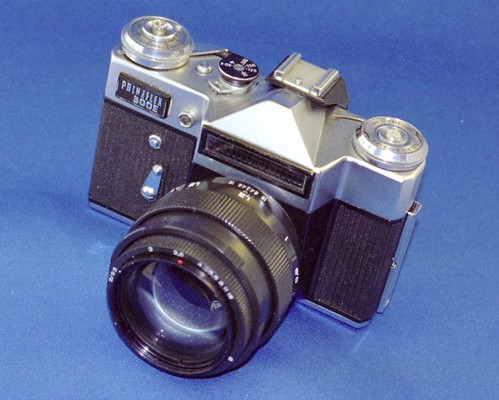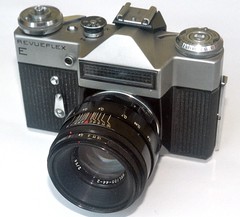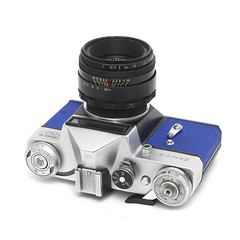Difference between revisions of "Zenit E"
m (pic) |
(extended (I have this camera and used it a lot in the past).) |
||
| Line 7: | Line 7: | ||
The '''Zenit E''' was a Russian-built [[SLR]] camera body for [[M42|M42 screw lenses]], made from 1965-1968<ref>http://www.rus-camera.com/camera.php?page=zenit&camera=zenite</ref>. The [[Zenit|Zenit range]] was quite popular since it was priced moderately and it was offered under several other trademarks or brands ([[Kalimar]], [[Revueflex]], [[Prinzflex]], Photokina, Spiraflex). | The '''Zenit E''' was a Russian-built [[SLR]] camera body for [[M42|M42 screw lenses]], made from 1965-1968<ref>http://www.rus-camera.com/camera.php?page=zenit&camera=zenite</ref>. The [[Zenit|Zenit range]] was quite popular since it was priced moderately and it was offered under several other trademarks or brands ([[Kalimar]], [[Revueflex]], [[Prinzflex]], Photokina, Spiraflex). | ||
| − | + | The camera offered fixed 1/30, 1/60, 1/125, 1/250 and 1/500 shutter speeds. It also had manual control for long duration exposures. Focusing was done either by the optimal image sharpness in the viewfinder or simply setting the distance in the distance scale. The distance scale was drawn against the calculator scale, showing the acceptable tolerance, depending on aperture. The minimal focusing distance was about 0.65 m with Industar 50 objective but the set of rings was manufactured for this camera, allowing to do the close distance macro pictures. | |
| − | It had a [[selenium meter]]. The meter's photo cell was placed above the lens mount behind a protecting window, and its instrument was placed beside a two-slice analog exposure calculator. A ring in the meter was coupled to that calculator on which the [[film speed]] had to be preselected, and when the meter's needle matched the ring the calculator showed the correct shutter-speed/aperture combinations. The [[Zenit B]] was similar to the E, but without the meter. | + | The [[Zenit EM]] was an upgraded version, with an automatic diaphragm. |
| + | |||
| + | It had a [[selenium meter]]. The meter's photo cell was placed above the lens mount behind a protecting window, and its instrument was placed beside a two-slice analog exposure calculator. A ring in the meter was coupled to that calculator on which the [[film speed]] had to be preselected, and when the meter's needle matched the ring the calculator showed the correct shutter-speed/aperture combinations. This device was not connected to the actual speed/aperture controls. | ||
| + | |||
| + | The [[Zenit B]] was similar to the E, but without the meter. | ||
<!-- This picture not there: {{Flickr_image | <!-- This picture not there: {{Flickr_image | ||
Revision as of 16:28, 28 December 2008

|
| A Zenit E, branded as Prinzflex 500E |
The Zenit E was a Russian-built SLR camera body for M42 screw lenses, made from 1965-1968[1]. The Zenit range was quite popular since it was priced moderately and it was offered under several other trademarks or brands (Kalimar, Revueflex, Prinzflex, Photokina, Spiraflex).
The camera offered fixed 1/30, 1/60, 1/125, 1/250 and 1/500 shutter speeds. It also had manual control for long duration exposures. Focusing was done either by the optimal image sharpness in the viewfinder or simply setting the distance in the distance scale. The distance scale was drawn against the calculator scale, showing the acceptable tolerance, depending on aperture. The minimal focusing distance was about 0.65 m with Industar 50 objective but the set of rings was manufactured for this camera, allowing to do the close distance macro pictures.
The Zenit EM was an upgraded version, with an automatic diaphragm.
It had a selenium meter. The meter's photo cell was placed above the lens mount behind a protecting window, and its instrument was placed beside a two-slice analog exposure calculator. A ring in the meter was coupled to that calculator on which the film speed had to be preselected, and when the meter's needle matched the ring the calculator showed the correct shutter-speed/aperture combinations. This device was not connected to the actual speed/aperture controls.
The Zenit B was similar to the E, but without the meter.

|
| Revueflex E |
Here the data of the Version "Prinzflex 500E"
- Type: SLR body
- Manufacturer: KMZ
- Film: 35mm, with speeds 16 to 500 ASA
- Lens mount: M42 screw mount without aperture release shifter
- Shutter: focal plane textile shutter, speeds 1/30 up to 1/500 sec. + B, switchable to flash synchro-mode (1/30s)
- Viewfinder: pentaprism finder, little round diopter correction lens mountable
- film advance: film advance lever, hidden rewind knob extends out from meter control
- Dimensions:137×92×53 mm
- Self-timer: with own release button and 15 sec. delay-time
Links

|
| Zenit-E |
=== Sources ===
further links
- Zenit E at www.collection-appareils.fr [1]
- User manuals for Zenit E at Michael Butkus Jr.'s [2]
- Revueflex E at Kurt Tauber's [3]
- French user manual at www.collection-appareils.fr [4]
- Zenit E on http://www.rus-camera.com